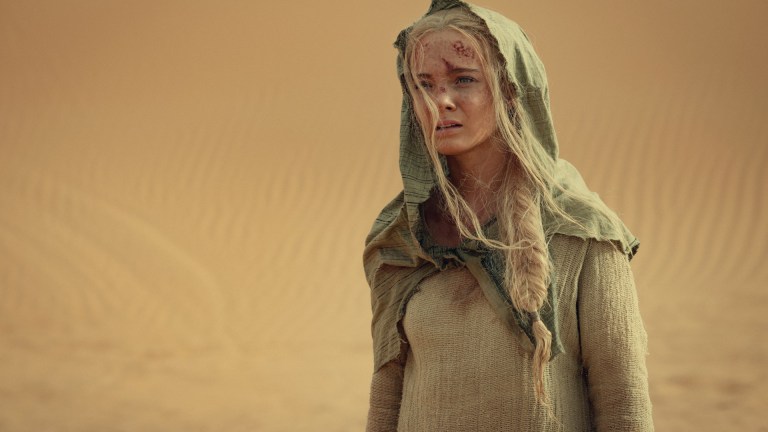The Witcher Season 3 Proves That Netflix’s Split Seasons Aren’t Working
Netflix needs to learn that just because you can split a TV season into halves, doesn't mean you should.

This article contains spoilers for You season 4 and The Witcher season 3.
As the streaming landscape continues to evolve, for better and for worse, companies like Netflix are trying to find new ways to stay relevant and keep people coming back to watch their movies and TV shows over the competition’s. Netflix is well known for making the binge-watch model of release popular, with entire seasons dropping on the streamer at once to encourage viewers to consume a series as fast as they can. But now that weekly episode releases are becoming popular again for TV shows on services like Hulu, Disney+, and Max, Netflix seems to be trying to find a way to keep up hype for their shows beyond the first week a season drops.
Rather than entirely scrapping the binge-watch model, Netflix has instead chosen to adopt a hybrid of sorts where they split seasons into two parts and release them separately. For some series, like Lucifer whose 16 episode fifth season was released in two eight episode parts nearly seven months apart, the split doesn’t have a noticeable effect on how the story plays out. In the case of Lucifer, the transition between parts feels like a natural mid-season cliffhanger, something that broadcast television has been perfecting for decades. However, for other series like You, The Witcher, and Stranger Things that have shorter seasons and whose parts are only released a month or two apart, it’s clear that this model isn’t working.
Stranger Things season 4 may not have been the first series that was split into two parts for Netflix, but it has certainly proven to the streaming service that this release model works monetarily. According to CNN, splitting the latest season of Stranger Things into separate parts for release wasn’t just a way to compete with other streamers and give the Duffer Brothers time to finish the rest of the season – it was a way to make them look good for their shareholders.
Without getting too deep into the nitty grittiness of business, essentially companies operate in quarters. Around the end of each quarter, they release a report to their shareholders detailing profits and losses during that time period. Part 1 of Stranger Things 4 was released May 27, 2022, which not only was a holiday weekend for many viewers, but was also during Netflix’s second business quarter of the year. Part 2 was subsequently released July 1 of the same year, which happened to be the first date of Netflix’s third quarter. With viewers eagerly waiting for the conclusion to the season, Netflix is less likely to lose subscribers between quarters, which is great news to report to their shareholders.
Of the other series that have been split into two parts – Ozark season 4, You season 4, Lucifer season 5, and The Witcher season 3 – You is the only one whose release wasn’t split between fiscal quarters. This may just be a coincidence, but as the WGA and SAG-AFTRA strikes continue to show us, many of these companies care more about their bottom line than the artform they’re selling and the creatives behind them.
In an interview with The Verge, The Witcher producer Steve Gaub said that the decision to split the show’s third season “came up during the edit,” and that the split “wasn’t written into the script” nor was it known while they were shooting that the season would be divided and released separately. The success of Stranger Things 4 played a role in this decision, but as we continue to learn in the streaming era, just because something is good for business, doesn’t mean it’s good for television.
You season 4 feels like two halves that don’t quite match each other. Part 1 is an intriguing whodunnit mystery that ends with the jaw-dropping reveal that Rhys (Ed Speleers) is the Eat-the-Rich Killer. While Joe Goldberg (Penn Badgley) is very much still a bad guy in part 1, the idea of introducing another killer that he doesn’t have a romantic relationship with is an intriguing premise for the first five episodes that keeps the show from feeling like it’s repeating itself.
However, part 2 seems to entirely undermine this change in pace by revealing only two episodes later that the murderer actually has been Joe the entire time, and that the killer version of Rhys that we’ve been seeing is the result of a psychotic break within Joe. It’s the kind of reveal that you would expect at this point in the season, if the season had dropped all at once. But because episode 5 was forced to be the mid-season finale despite not being written as such, the reveal that Rhys is the killer holds more weight.
Instead of the second half of season 4 being about Joe stopping Rhys, as the end of Part 1 seems to point to, it becomes about Joe spiraling to keep himself from being caught until ultimately he gets a gold pass from his current love interest Kate (Charlotte Ritchie) to embrace his killer side instead of suppressing it.
The Witcher season 3 similarly feels divided because of its split. The first five episodes of season 3 are some of the strongest of the series thus far, and episode 5 brings everything together beautifully at the Conclave of Mages. We find out that the Rogue Mage is really Vilgefortz (Mahesh Jadu), that Dijkstra (Graham McTavish) and Philippa (Cassie Clare) seem to have some tricks up their sleeves, and that the hottest couple on the continent, Yennefer (Anya Chalotra) and Geralt (Henry Cavill), are back together at last.
The first episode of part 2 continues this story by picking up right where part 1 left off, with the attack on Aretuza by Dijkstra, Phillipa, and Redanian soldiers. The Scoia’tael, Francesca (Mecia Simson), Fringilla (Mimî M. Khayisa), and Cahir (Eamon Farren) arrive soon after, escalating the violence further. The mages do their best to defend Aretuza while Geralt takes on Vilgefortz alone. While the battle rages on, Ciri (Freya Allan) activates Aretuza’s monolith, destroying the tower it resides in and vanishing to the deserts of Korath in the process.
This climactic battle and the chaos that follows is the perfect ending to the story we’ve been following since the start of the season, but instead of ending the story there, it continues for two more episodes to round out part 2. Part 1 feels like a cohesive unit of episodes about Ciri, Geralt, Yennefer, and Jaskier (Joey Batey) as a sort of found family and the growing conflict on the Continent while part 2 is a disjointed mess that would have been better if they left episodes 7 and 8 for another season.
Had the season’s episodes dropped all at once as the series has done in the past, episodes 5 and 6 would feel like a more natural midpoint for the season’s story and the last two episodes may not feel so disconnected from the story as a whole. But by forcing the fifth and sixth episodes of the season to serve as an end and a beginning of chapters, rather than the middle they were written to be, the story suffers.
While splitting seasons after they’re written might not necessarily affect the progression of events in the story of You or The Witcher, it affects how we perceive them. The anticipation of seeing how a mid-season cliffhanger resolves tends to be greater when you have to wait for the next episode, even if the wait is only a month. When the tension presented in the mid-season cliffhanger isn’t allowed to build throughout the rest of the season and is resolved immediately in the case of The Witcher’s battle for Aretuza in episode 6 or negated almost entirely when Joe is revealed to be the killer once again two episodes into part 2 of You, it makes it harder for the rest of the season to live up to expectations and deliver a conclusion that feels just as interesting and gripping.
But it’s not the fault of these shows that Netflix still doesn’t understand how good television works. If a show is going to be told in parts, it needs to be written as such from the beginning so that midseason cliffhangers, climactic moments, and important reveals flow together and enhance the story. In You, The Witcher, and even Stranger Things 4, the episodes chosen to serve as the respective mid-season finales feel like they were chosen to provide just enough shock value and intrigue to keep subscribers signed on for another month, not because they were the right place to stop the story. Revealing Vecna’s true identity in Stranger Things 4 is an important part of the story, but by using that impactful moment to end part 1, all that really leaves us narratively for part 2 is the big boss fight against him.
Netflix has drastically changed how we make and consume television, and splitting shows into parts is just another way for them to try to reap the benefits of network TV without regard for what makes network TV work in the first place. Series that have traditionally been created to be binged shouldn’t suddenly have to carry the narrative weight of mid-season finales and cliffhangers just because it’s better for Netflix’s bottom line. Planning a season around a big mid-season reveal or climactic event is something that should happen in the writers room, not after the season has already been written and filmed for a different release model. Releasing seasons in parts may be working financially for Netflix, but it’s negatively affecting the stories that the creatives behind these shows work so hard to tell.
All eight episodes of The Witcher season 3 are available to stream on Netflix now.
